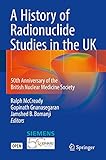A History of Radionuclide Studies in the UK [electronic resource] : 50th Anniversary of the British Nuclear Medicine Society / edited by Ralph McCready, Gopinath Gnanasegaran, Jamshed B. Bomanji.
Tipo de material: TextoEditor: Cham : Springer International Publishing : Imprint: Springer, 2016Edición: 1st ed. 2016Descripción: XVIII, 152 páginas74 ilustraciones, 57 ilustraciones in color. online resourceTipo de contenido:
TextoEditor: Cham : Springer International Publishing : Imprint: Springer, 2016Edición: 1st ed. 2016Descripción: XVIII, 152 páginas74 ilustraciones, 57 ilustraciones in color. online resourceTipo de contenido: - texto
- computadora
- recurso en línea
- 9783319286242
- 616.0757 23
Introduction: The history of Nuclear Medicine in the UK -- The evolution from Radioisotope departments administered by Physicists with an emphasis on in vitro and vivo investigations to Nuclear Medicine Departments encompassing Imaging and therapy -- The history of the British Nuclear Medicine Society -- The development of the society from primarily a medical group to a scientific society which includes all disciplines -- From Houseman to Consultant in Nuclear Medicine -- The evolution of training in Nuclear Medicine, to include the MSc and RCR training -- Technician and Radiographer to Clinical Practitioner -- The Institute of Nuclear Medicine -- Radionuclide studies of the pathology of the brain -- Nuclear Cardiology + The Royal Brompton Department -- Paediatric radioisotope studies + Great Ormond Street Dept -- Renal studies + St Barts Department -- Radiotracer studies of human physiology -- Nuclear Medicine at the Hammersmith Including Malcolm Merrick's work -- Monoclonal Antibody studies plus Nuclear Medicine in Nottingham -- Development of medical cyclotrons and PET in the UK -- Bone radionuclide imaging and quantitation and bone densitometry -- Radionuclide Therapy -- Hospital Radiopharmacy -- Evolution of nuclear medicine physics in the UK -- Development of computers in Nuclear Medicine -- The history of the protection of the patient in human radionuclide studies in the clinic and research -- The future direction of radiopharmaceutical development.
Open Access
The British Nuclear Medicine Society celebrates its 50th Anniversary with this booklet, which reflects the research of many of the pioneers in the use of radionuclides for the diagnosis and therapy of human disease. Since 1949 there have been remarkable advances in radionuclide techniques and imaging equipment: from the first devices "home-made" in the many physics departments throughout the UK, to the sophisticated multimodality imagers now in everyday use in Nuclear Medicine. The BNMS has been instrumental in promoting the use of radionuclide techniques in the investigation of pathology by supporting and providing education, research and guidelines on the optimum use of radiation to help patients. The future of Nuclear Medicine is bright, thanks to improved imaging resolution, new radiopharmaceuticals, and new diagnostic and therapeutic techniques and procedures.
No hay comentarios en este titulo.
